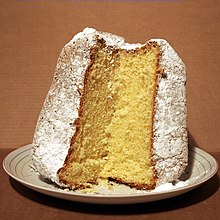Pandoro
A Pandoro ( Italian Pan d'oro = "golden bread") is a traditional Italian Christmas cake. The Pandoro is similar to the Milanese panettone and originally comes from Verona . The name of Pandoros probably comes from the characteristic golden yellow color that is due to the eggs in his recipe.
The Pandoro is baked from yeast dough and, unlike the Panettone, contains neither raisins nor candied fruit. Typical of the Pandoro is the jagged dome shape, which is achieved with a corresponding octagonal, star-shaped baking pan . The Pandoro is usually sprinkled with powdered or vanilla sugar so that the cake resembles a snow-covered mountain peak. Cut horizontally, the cake slices look like a star.
history
The tradition of Pandoros in Italy goes back to the 18th century. In France it is assumed that the brioche is a forerunner of the Pandoros and that its history goes back to the 1st century. Virgil and Titus Livius described a similar type of bread and called it libum . In Italy it is believed that the Pandoro is of purely Italian origin and was invented during the Renaissance . In rich Venice, layers of gold leaf were placed on the cake, which is another interpretation of the origin of the name.
Web links
Individual evidence
- ↑ Golden bread. In: The Standard . Edition December 12, 2007.


